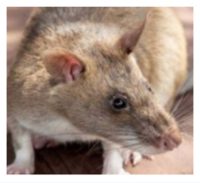MHF TOP PICKS FOR JULY
Every month, we at the Mueller Health Foundation like to showcase interesting news and updates in the field of tuberculosis (TB). Below are our top 3 picks for July:
- New Study Confirms HeroRATs Boost TB Detection, Outperforming Even Advanced Diagnostics
Researchers evaluated the added value of African giant pouched rats, trained by APOPO, for tuberculosis detection in Tanzania by re-screening sputum samples that were initially negative by smear microscopy or Xpert at health facilities. Across 34,565 presumptive TB patients and 43,153 samples collected in 2023, the rats identified 2,176 additional TB-positive cases, representing a 48% increase over cases detected by routine diagnostics. The incremental yield was higher at smear-based sites (59%) compared to Xpert sites (44%), and the rats were 47% more likely to detect TB in samples with low bacillary loads that were missed by Xpert. The study also found that detection performance was consistent across children and adults, as well as across varying bacillary loads. Overall, trained rats provided a significant boost to TB case detection, particularly in settings relying on less sensitive diagnostic methods, thereby highlighting their role as a valuable second-line screening tool in resourcelimited environments. To learn more, you can access the study at: https://journals.plos.org/plosone/article?id=10.1371/journal.pone.0321866
- Beetle‑Inspired Credit Card‑Sized TB Test Improves Detection in People with HIV
Tulane University researchers have developed a handheld, electricity‑free tuberculosis diagnostic device, inspired by the chemical defense mechanism of the bombardier beetle. Known as ASTRA (Antigen‑Specific T‑cell Response Assay), this credit‑card‑sized test uses a drop of blood and a beetle‑inspired chemical propellant to deliver results in about four hours, versus the Interferon-Gamma Release Assay (IGRA)’s 24–48 hours, without need for electricity, lab facilities, or specialized staff. In clinical trials, ASTRA demonstrated 87% specificity in detecting TB among HIV‑positive individuals, outperforming standard IGRA testing (60%), and identified novel T‑cell biomarkers that remain effective even in immunocompromised patients.This rapid, portable assay holds promise for enhancing TB detection and treatment in high-burden, low-resource settings, particularly among populations most at risk. To learn more, you can read about the research here: https://www.nature.com/articles/s41551-025-01441-5
DID YOU KNOW?
The United States continues to grapple with a resurgence of tuberculosis. In 2024, the CDC reported 10,347 provisional TB cases, reflecting an 8% increase from the previous year and marking the highest case count since 2011, with an incidence rate of 3.0 per 100,000 persons. This uptick spans 34 states and D.C., with key drivers including increased international travel, post-pandemic migration, and the reactivation of latent infections due to weakened immunity. Of these cases, California leads the nation, accounting for approximately 22% of all U.S. TB cases, followed by Texas, New York, and Florida.
Florida has recently made the headlines after confirming a case at Dillard High School in Fort Lauderdale and another at a federal detention center in Miami, signaling growing concern among health officials. In Florida, TB cases climbed by 9%, totaling 681 reported cases (2.9 per 100,000) in 2024. The highest concentration was observed in Miami-Dade and Broward counties, with the majority of cases occurring among non–U.S.–born individuals, particularly those from Latin America and the Caribbean.
Meanwhile, Kansas is continuing to deal with one of the most significant TB outbreaks in recent memory. The Kansas Department of Health and Environment identified 67 active cases and approximately 79 latent infections in Wyandotte and Johnson counties in early 2025, a surge from 51 active cases the year prior.
These recent outbreaks underscore the importance of robust contact tracing, widespread testing, and adherence to CDCrecommended control measures. Furthermore, these stark developments highlight urgent needs: expanded latent TB screening among high-risk and immigrant populations, enhanced post-treatment monitoring, and strengthened communitybased public health infrastructure. Without proactive strategies like targeted screening, treatment support, and education, the recent upward trend may undermine decades of progress in TB control.

